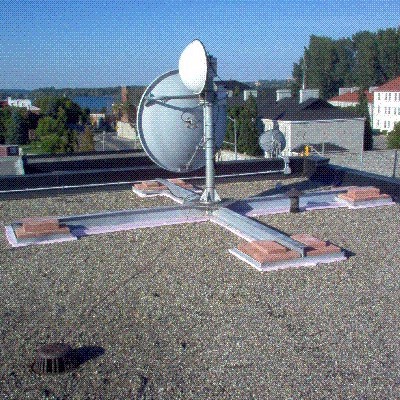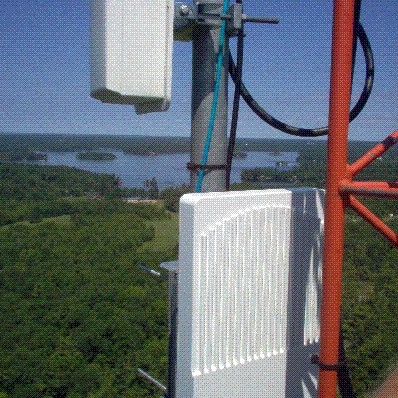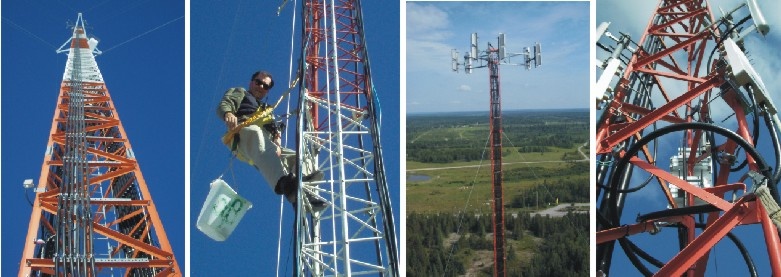Broadband Towers
We have been developing wide area high-speed wireless networks in eastern Ontario for many years. We built the infrastructure that some of the largest wireless Internet Service Providers (ISP) in Eastern Ontario are using, rent space on our towers for antenna co-location for broadband applications to others and have developed microwave broadband links exceeding 1.5 Gbps in the 80 GHZ spectrum using the E-Link 1000 and Wavebridge technologies.
We are familiar with Dragonwave technologies, have installed Huawei 3G equipment and antennas for the Bell Mobility network and have integrated various mediums such as fiber optic connection and wireless transmitted signals to bring broadband data to remote locations at high speeds.
For more detailed information on the services we provide and the work we do, please click on one of the links in the menu or contact us.
We are familiar with Dragonwave technologies, have installed Huawei 3G equipment and antennas for the Bell Mobility network and have integrated various mediums such as fiber optic connection and wireless transmitted signals to bring broadband data to remote locations at high speeds.
For more detailed information on the services we provide and the work we do, please click on one of the links in the menu or contact us.


Left: Broadband transmitting antennas on 400 ft tower near Algonquin Park in Ontario
Right: Custom designed non-penetrating roof-mount for microwave link for high-speed point-to-point links installed on roof-top in the city of Kingston, Ontario
Right: Custom designed non-penetrating roof-mount for microwave link for high-speed point-to-point links installed on roof-top in the city of Kingston, Ontario


Right: Vcom ODU for broadband transmission replacement in eastern Ontario
Broadband Tower Location & Height
Selecting a site for a broadband tower location involves consideration of a number of factors. The basic considerations indicated below do not include Fresnel Zones, Fade Margins, Rock Formations, or lakes/rivers that might effect the signal propagation or interference from other sources, etc.
The following information is intended as a very general guide only. Please contact our office for a complete path analysis and propagation study.
Point-to-Point
Point-to-Multi-Point
Selecting a site for a broadband tower location involves consideration of a number of factors. The basic considerations indicated below do not include Fresnel Zones, Fade Margins, Rock Formations, or lakes/rivers that might effect the signal propagation or interference from other sources, etc.
The following information is intended as a very general guide only. Please contact our office for a complete path analysis and propagation study.
Point-to-Point
- Find a suitable, elevated site for your tower;
- Obtain a topographical map, Google Earth, etc. and find your proposed location. Record the height, longitude and latitude of the site;
- Check for the highest elevation between your proposed tower location and identify the topographical height of the originating signal;
- Draw a straight line on your topographical map, linking the source of the originating signal with your proposed tower site and calculate/measure the distance between these 2 points;
- Assume that trees in eastern Ontario grow to a height of 80 feet;
- Allow some extra height as a safety margin and allow for Fresnel zones;
- Are there any man-made structures in the signal path such as tall buildings, silos, hydro towers, etc?
- Draw a graph to scale where the X-axis identifies height referenced to see level and the Y-axis distance;
- You will need to identify 3 points on the graph: The source signal, the highest elevation between the source and your proposed location and your new tower site.
- Mark the height of the source signal, the height of the highest elevation between the source and the proposed tower location on the graph and connect those 2 points with a straight line that then continues past your proposed tower location;
- Measure that height on the graph and calculate tower height. You can also use trigonometry to calculate distances, angles and height through information obtained from a topographical map, Google Earth, etc.
Point-to-Multi-Point
- Identify your projected coverage area, keeping in mind that microwave signals need line-of-sight; Claims made by various manufacturers that their microwave transceivers do not require line-of-sight should be taken with caution since even though that might work in urban environments where the signals can bounce off buildings, it usually does not work in suburban or rural areas.
- Use a topographical map, Google Earth, etc. and check for changes in elevation. Your signal sources are now the various antennas (multiple sectors or panels and/or omni) that will propagate the signals downwards to your various subscribers.
- Most sectors and/or panel antennas have a mechanical down-tilt that can be adjusted for maximum performance. Check the radiation patterns of your antennas carefully so that they can be employed for maximum performance;
- Remember that line-of-sight during the winter may not be line-of-sight in the summer. Leaves absorb microwave energy the same way that a sponge absorbs water and depending on how thick the foliage is, your microwave signal might be absorbed by the moisture content in leaves before it gets to the subscriber;
- A hilly terrain introduces shadow effects that will cause spotty signal coverage. The higher the frequency, the more critical is line of sight and the higher the shadow effects;
- Once you have identified the height of tower, its location and the various antennas required for your operation, you can contact a company like ours for a quote or you can contract us to do the site analysis with the required propagation studies.

Different types of towers for broadboad application
